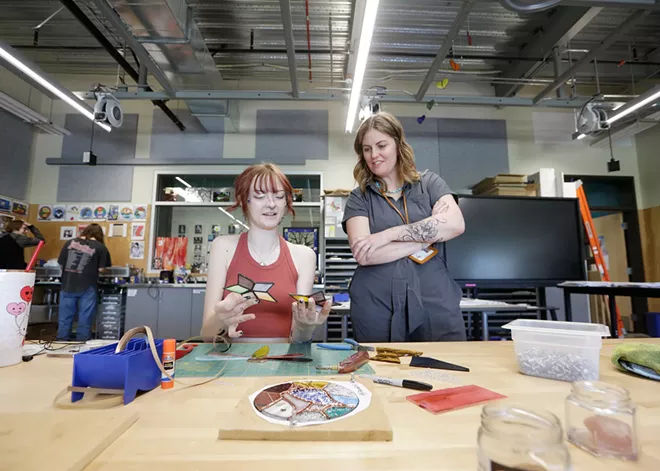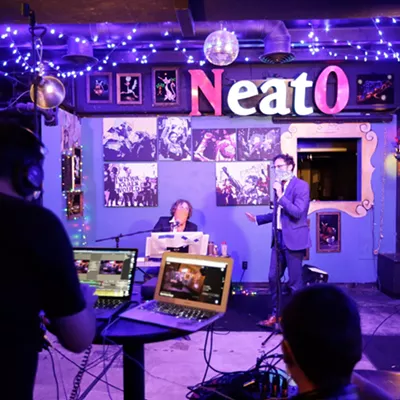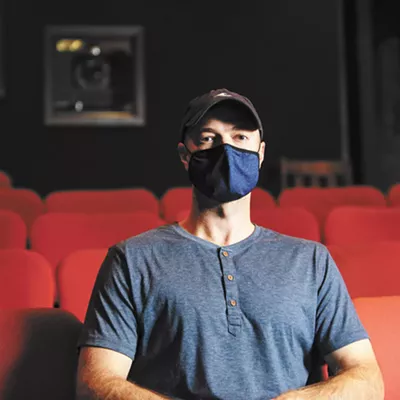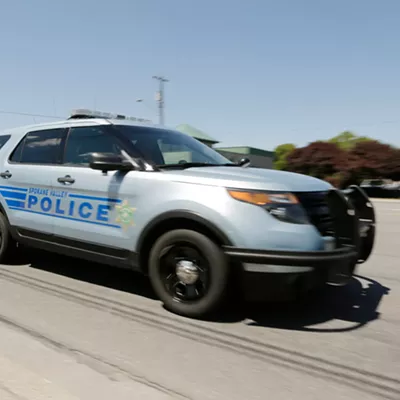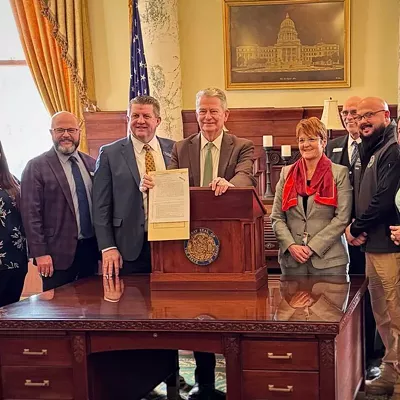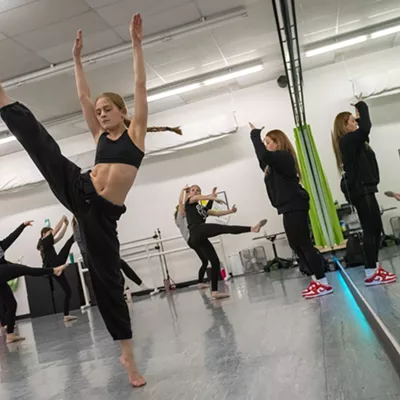Flashes of reds, greens and yellows glimmer in the sunlight as Aliauana Humphries proudly shows off one of the first stained glass pieces she made at Spokane's On Track Academy. Right now she's only learning the basics, so pieces of textured glass sit soldered together into a rectangular frame. But judging by her artsy acrylics — that she learned to do herself — it'll be no time before these pieces hang somewhere else. A friend's house or an art gallery, perhaps.
Humphries hasn't always been proud of the work she's done in the classroom. She quickly fell behind during her first year at North Central High School, which really wasn't for her anyway, so she dropped out before her sophomore year.
"I had so much work built up that had passed their deadlines, so I wouldn't even get full credit if I did a good job," says Humphries, who is 18. "It just makes you feel like there's no point in trying."
The entire experience was overwhelming and seemed like punishment, so she never had plans to graduate high school, let alone go to college.
That is, until she enrolled in the Spokane Public Schools' Open Doors program, which essentially gives students one last try at a high school education, on terms they can deal with. Whether they dropped out due to behavioral issues, mental health concerns or truancy, this program offers them the opportunity to complete their K-12 education.
For the past 15 years, On Track Academy, which is part of SPS, has offered an alternative approach to education for students throughout Spokane Public Schools. Instead of six periods throughout the day, students at On Track Academy are enrolled in a block period that is co-taught by two instructors. Instead of rotating through multiple classes daily and keeping up with tons of classwork, students go through education that is structured to their individual needs.
For the past three years, On Track has offered its students the Open Doors program, which is open to people between the ages of 16 and 24 who have dropped out of school and are not expected to graduate before age 21. The program offers multiple paths for students: high school completion, work preparation and training, taking college-level coursework. But a primary focus is getting students to pass the GED — a General Educational Development test that basically translates to a high school diploma if passed.
As attendance rates have yet to recover from the disastrous effect of COVID, On Track thinks it has a path to student success — and that knowledge has come from listening to what the students needed.
"From my experience, [students] love to learn, but we've just found ways to take that away," says On Track teacher Karina Berven, who works with the Open Doors program. "So right away we try to figure out what these students are interested in."
Berven's personalized approach to education — an approach that she says works best for students who have stopped attending school — has allowed her to easily connect and foster relationships with each student.
"It's just not possible in a traditional, comprehensive high school or middle school to have a relationship with students in that way," she says. "I can teach them the things that I'm supposed to teach them while getting to know some really cool people. It's just very hard not to love it."
"From my experience, [students] love to learn, but we've just found ways to take that away."
One size has never fit all in education. While the traditional approach to a K-12 education may work for most students, many still fall through the cracks.
In 2007, the Washington Office of Superintendent of Public Instruction began to focus on students who had often fallen through these fissures. This mainly includes older students who didn't have enough credits to graduate from high school on time or who dropped out entirely.
The Open Doors program was created by the state Legislature in 2010 through House Bill 1418. From there, the number of schools that offered the program grew exponentially. During the 2016-17 school year, 93 school districts and more than 8,000 students participated in the program.
And it was just in time.
Five years ago, the state superintendent's office recorded a statewide four-year graduation rate of 81 percent, just 2 percentage points below its apex of 83 percent in 2019-20.
Then, during the COVID pandemic, different yet related numbers started to plummet. Statewide, 91 percent of students regularly attended school in the 2019-20 school year. Late that school year, the virus began to spread widely. In the 2020-21 school year, regular attendance dropped to 81 percent statewide before falling again to 67 percent in the 2021-22 school year.
At Spokane Public Schools — one of the largest school districts in the state with 29,396 students — the trend was similar. In those same three school years, SPS went from 95 percent of students regularly attending in 2019-20 to 86 percent in 2020-21 and finally to 72 percent in 2021-22.
Since fewer students are attending school as often as their peers, programs like Open Doors may seem appealing. But SPS Graduation Assistance Specialist Jeremy Day warns that this program may not work on a larger scale or for all students.
For example, the interpersonal relationships that Berven builds would not be possible if the program expanded too much. Berven's class size is far smaller than a normal secondary teacher's load would be. And, unfortunately, the funding needed to keep classes small just isn't there.
That doesn't mean slow, small growth for the program isn't possible though.
After gauging the needs of students, On Track Academy has been able to hire a second teacher for a second Open Doors classroom. On Track's principal, Chris Burke, says it was important to grow the program because that's what the community needs. However, he agrees with Day that the program may not work for students on a larger scale.
"We need to be cognizant of keeping [Open Doors] personalized and small because that's what a lot of students are feeling like they need," Burke says.
"Being so small truly helps here because you have the opportunity to have that personal connection and get to know everyone else as a person," Humphries agrees.
For Humphries, the two-hour school days and a self-paced curriculum at Open Doors made her feel empowered to start again. Like other students in the program, when she began the program her only goal was to get her GED.
She passed the test, but she wasn't ready to stop.
"The school really brought back that motivation and excitement for school that I've never really felt, besides in elementary school," Humphries says. "It made me realize that I love learning."
Humphries is finishing up the remaining elective credits she needs for her high school diploma including by participating in a stained glass program. When she graduates this year, Humphries plans to attend Spokane Community College. ♦

